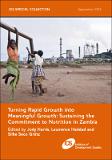| dc.contributor.author | Harris, Jody | |
| dc.contributor.author | Haddad, Lawrence | |
| dc.contributor.author | Seco Grütz, Silke | |
| dc.coverage.spatial | Zambia | en_GB |
| dc.date.accessioned | 2014-09-22T08:36:20Z | |
| dc.date.available | 2014-09-22T08:36:20Z | |
| dc.date.issued | 2014-09-22 | |
| dc.identifier.isbn | 978 1 78118 181 2 | |
| dc.identifier.uri | https://opendocs.ids.ac.uk/opendocs/handle/20.500.12413/4463 | |
| dc.description.abstract | The level of undernutrition in Zambia is high and persistent. The increasing commitment of Zambian and international stakeholders to changing this situation holds out the prospect of a real decline in undernutrition over the coming years. In addition, the current strong growth of GDP per capita is potentially a positive driver of future undernutrition decline. Despite these increased opportunities for undernutrition reduction, however, there are several real threats to progress. Based on a combination of research evidence and long experience of working in the country, the authors in this IDS Special Collection describe some of these opportunities and threats in Zambia and suggest ways of seizing the former and dealing with the latter.
The articles in this IDS Special Collection show how the commitment to nutrition has been built in Zambia, and provide some pointers and guides to the ways in which that increased commitment could be leveraged to raise resources and how to allocate these. Zambia is potentially on the cusp of a great economic transformation. Can gains in economic growth from temporary mineral resources be translated into gains in child growth which reduce
mortality and suffering, as well as serving to power economic growth in a sustainable way? Or will we see a situation where current fast economic growth is another redundant flash in the pan? By investing much more of their increasing stream of tax revenues in malnutrition-reducing efforts, Zambian policymakers can make the transformation vision much more likely. In this way, economic growth can be made more sustainable and more
transformative. Investing in the most vulnerable members of its society – children under the age of two and their mothers – is a sure-fire way for Zambia to turn fast economic growth into meaningful growth, not only of its economy, but of its population. | en_GB |
| dc.language.iso | en | en_GB |
| dc.relation.ispartofseries | Special Collection; | |
| dc.rights | This is an Open Access report distributed under the terms of the Creative Commons Attribution 4.0 International License, which permits unrestricted use, distribution, and reproduction in any medium, provided the original authors and source are credited.
http://creativecommons.org/licenses/by/4.0/legalcode | en_GB |
| dc.rights.uri | http://www.ids.ac.uk/files/dmfile/IDSOpenDocsStandardTermsOfUse.pdf | en_GB |
| dc.subject | Nutrition | en_GB |
| dc.title | Turning Rapid Growth into Meaningful Growth: Sustaining the Commitment to Nutrition in Zambia | en_GB |
| dc.type | Series paper (IDS) | en_GB |
| dc.rights.holder | Institute of Development Studies | en_GB |
| dc.identifier.team | Knowledge Services | en_GB |

